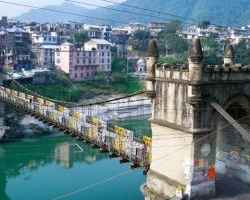In the absence of authentic historical record the early history of Kinnaur region is obscure and the reference of the Kinnaura or Kannaura and there land is by the large confined to legends and mythological accounts. It would be worthwhile to look at the region of Kinnaur alongwith general conditions of northern India particularly the hilly regions of Himalayas during the period from 6th century B.C. India was divided in to sixteen geat janpadas and several smallers ones. Among them Gandhara, Kamboja, Kuru, Koshal, Mull, Vajji, Panchal, Sakya were either in the southern Himalayas ranges or had territories extended up to Himalayans ranges. Among the states that were flourishing in the six century B.C. The kingdom of Magdha was the first to make a successful bid for supermacy under Bimbisara.
Its emperor belonging to Sunga, Nanda and Maurya dynasties carried their banners upto the inhabitated parts of inner Himalayan region.Chandragupta Maurya brought about its political unification under one scepter, negotiated an alliance with Parvataka (Himalayan King) before empire building. With the help of several frontier tribes such as Kiratas, Kambojas, Panasikas and Valhika, he built up the great Mauryan Empire.The empire of Ashoka extended upto natural boundaries of India and beyond that in the west. After the collapse of the Mauryan empire the Kushanas established an extensive empire within and beyond India in the northwest. Emperor Kanishkas hegemony spread over Kashmir and the Central Asian regions of Kashgar, Yarkand and Khotan. His hold extended upto the territory of the Inner Himalayas and Kinnaur must have been the part of this empire. In the meantime northern India was divided into a number of small kingdoms and autonomous tribal states. Under such a divided country the Gupta empire grew. Samundragupta's empire included the territories of Rohilkhand, Kumaon, Garhwal, Nepal and Assam. Its northern boundary was along the high Himalayas. Kinnaur must have been included in it too. Early in the seventh century A.D., Harsha came to power at Thaneshwar in A.D. 606. During the course of four decades he had established a most powerful empire in India. All the existing kingdoms of Kapisa, Kashmir, Kuluta, Satadru, Mon-li-pa-lo (Ladakh) and Suwarnagotra (in the high Himalayas) were incorporated in his empire. After the death of Harsha in A.D. 647 the country was once again divided into old principalities of the sixth century B.C.
It appears that the princes being adventurous owing to territorial greed, first went to these high hills and established themselves on varying territories in accordance with their powers. Particularly the area between Satluj, its tributaries and Baspa upto Mansarover was under the rule of Thakkers from very early times. They were known by the place they had occupied like that of Chini Thakur and Kamru Thakur, under the overall suzerainty of Mauryan and Gupta kings later on. It was the Thakur of Kamru who proved strongest of all the other chiefs of the area and annexed their territories by force sometime after the fall of the Kanauj Empire and laid the foundation of the state of Bushahr, to which the region of Kinnaur belonged till the dissolution of the state very recently--





Comment with Facebook Box